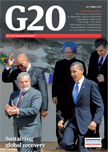

 |
 |
|

From Conventional to Creative Energy Supply Strategies
By Victoria V. Panova, Moscow State Institute of International Relations
To download a low-resolution pdf, click here. (Be patient! It's 7.7 MB.)
Non-conventional energy resources offer clean and innovative alternatives, but implemention is not always straightforward/
The multifaceted economic crisis continues. Some say the world is now in the process of stabilisation and will have recovery soon. Others see many difficulties remaining. Most agree that unlike the energy crisis in the 1970s, the energy sector did not trigger today’s proliferating global financial and economic disaster. But oil market volatility, growing demand for hydrocarbons, political unrest in the producing or transit countries, and the knowledge that hydrocarbons are depletable resources have all contributed to the instability of the global economy in the first decade of the 21st century. To deal with these challenges, the world needs to shift from its over-reliance on hydrocarbons to a wider use of innovative, more climate-compatible and environmentally friendly alternative sources of energy.
Non-conventional energy supply still occupies a minor share in the global fuel and energy balance. Only a few countries, such as Iceland, enjoy a natural advantage here. Thus, with today’s financial crisis and the volatile price of oil, which last year reached a historic high of $147 per barrel before plummeting to below $50, there arose the danger that most investments in alternative and renewable energy sources would be frozen, as there are fewer commercial incentives there than with hydrocarbons. The price for oil has now stabilised around $70, which makes possible politically motivated investments in non-conventional energy. But the crisis has also led to delayed development of renewable energy projects, as many companies seek changes in regulations and decreased prices along the supply chain.
There is today a growing awareness of the need to switch to non-conventional resources. For example, the use of hydropower reached 2.8 per cent of global energy consumption in 2008, with China leading at 20.3 per cent on strong capacity growth and increased rainfall. Global wind energy capacity over the past year grew around 29.9 per cent, with markets in the United States and China growing fastest. By 2012 the wind market could grow by more than 155 per cent to reach 240 gigawatts (GW) of total installed capacity; by 2020 it could reach 8 per cent of global electricity demand, with more than 1,000 GW of installed capacity. In addition, over the past year solar power grew by 69 per cent. Biofuel production continues to develop, especially in the US and Brazil, although concerns remain regarding its compatibility with food security.
Nuclear energy could be seen as alternative energy. But it is still highly resisted by a large part of the global community. In Beijing in 2009, Mohamed ElBaradei, the head of the International Atomic Energy Agency, noted that although the economic crisis has led to decreased interest in nuclear energy, by 2030 demand for it will likely grow to 66 per cent, compared to today’s 16 per cent. Over the past year, nuclear output has shown signs of decline of around 0.7 per cent. But it will likely maintain positive momentum thanks to the policies of China, India, Russia, the US and Korea, whose governments consider nuclear energy an effective means to a green and climate-friendly economy. Decline is nonetheless expected in Europe, with the closures and phase-out policies of the United Kingdom, Germany, Sweden and Belgium.
At L’Aquila in July 2009, the G8 together with its five partners in the Heiligendamm-Aquila Process agreed on several common points on green energy. The leaders called for retrofitting coal plants and creating a ‘Sustainable Buildings Network’ to share information and best-practice examples. Their most important achievement was to involve “renewable energy in economic stimulus plans as a contribution to a green economic recovery”. Most measures taken concern tax concessions, but promotional rates and hybrid tariffs are included.
The European Union, with its 20/20/20 Plan, is trying to maintain momentum and intellectual leadership by promoting new ideas and leading by example. Member countries have the means to introduce renewables, largely ensured by government subsidies, high levels of technical and economic development, and low rates of traditional resource-demand growth.
The United States is also adopting specific measures, such as the Troubled Asset Relief Program, the Emergency Economic Stabilization Act of 2008 and tax incentives aimed at developing renewable energy and energy conservation (for example, energy-efficient buildings, industries and transport). The next step in overcoming the anti-climate change legacy of George Bush’s administration was the Clean Energy and Security Act (the Waxman-Markey bill). It was pushed through the House of Representatives on 26 June, on the eve of the G8 L’Aquila Summit, although it has not yet been passed by the Senate.
China and India have adopted laws to support their renewable energy industries. At the first summit of Brazil, Russia, India and China – the BRICs – in June 2009, even recognising their differing approaches, leaders agreed to diversify energy resources further, specifically emphasising renewables, new energy infrastructure and new investments. Their statement was backed up by several joint projects. Nevertheless, for those countries and, to a greater extent, for poorer developing countries, conventional energy still plays a large role because initially very little investment is required to meet basic energy needs and maintain economic growth. That is why the European model prioritising environmental considerations over economic ones is unacceptable to these countries. Hydrocarbon use will likely remain dominant in these countries, possibly leading to further polarisation between the core and the periphery of the global economy.
At Pittsburgh, the G20 leaders will focus on economic issues. But sustainable energy development implies sustainable economic development. Thus the G20, which includes both producers and consumers, provides a good forum for exchanging ideas and bringing together differing positions, and for lobbying through international organisations for the adoption of specific measures.
The G20 might contribute intellectual and governance leadership to the Energy and Climate Change Advisory Group launched by United Nations secretary general Ban Ki-moon, including assisting with specific projects such as ways to lower construction costs of hydropower stations in Africa.
A wide variety of national incentives or soft sanctions should be introduced to promote alternative and renewable energy by all the members of the G20 including the EU. One way is to introduce specific trade benefits for those countries pursuing environmentally and climate-friendly policies.
The G20 should raise the question of technology transfer and try to settle the issue of intellectual property rights compatible with interests of both developed and developing countries, and also to allow developing countries to have clean and efficient technologies and introduce a more sustainable energy mix.
The G20, being more representative than the G8, has a better chance to lead in tackling many global problems. The litmus test of the efficiency of the new leaders-level G20 will be the outcomes of Pittsburgh: the successful management of the global economy, proper exit strategies and the reform of the global financial architecture. If those decisions prove to be meaningful and substantial, the G20 will be able to assume management of a variety of global issues beyond, notably, climate and energy security, taking up where the G8 leaves off.
|
This Information System is provided by the University of Toronto Library |
All contents copyright © 2024. University of Toronto unless otherwise stated. All rights reserved.